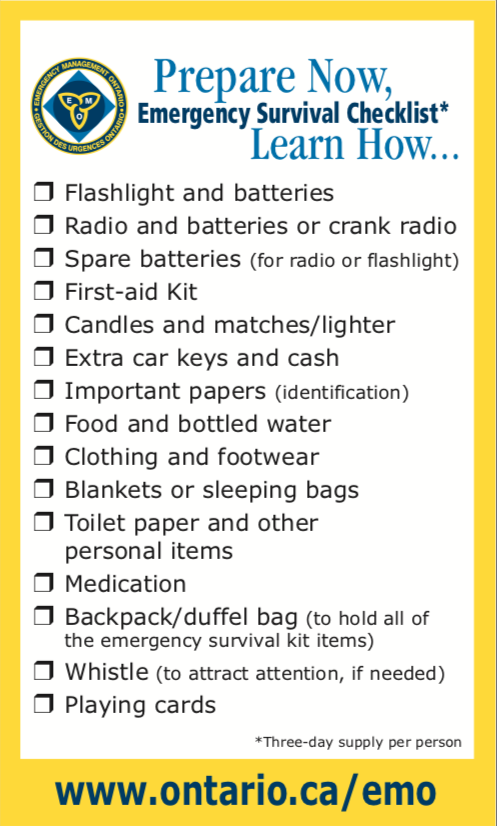Emergency Preparedness
HOW CAN YOU BE READY FOR AN EMERGENCY?
1: Know the Risks
Although the consequences of various disasters can be similar, knowing the risks in your region can help you better prepare. Across Canada, we face a number of hazards, such as earthquakes in British Columbia, blizzards in Nunavut and tornadoes in Ontario. In addition to natural disasters, there are other types of risks, such as power outages and industrial or transportation accidents.
Find out the risks most likely in your community by visiting the ‘Know the risks' section from the GetPrepared.ca website.
2: Make a Plan
Every Canadian household needs an emergency plan. It will help you and your family know what to do in case of an emergency.
Your family may not be together when an emergency occurs. Plan how to meet or how to contact one another, and discuss what you would do in different situations.
It only takes 20 minutes to complete a personalized plan online. You can then print it out. Most of this information can be filled out on your own. You may need to get some information from your municipality. To complete your emergency plan online, visit the ‘Make an emergency plan' page from the GetPrepared.ca website.
To fill out your home emergency plan, you will need to think about the following:
Safe exits from home and neighbourhood
Meeting places to reunite with family or roommates
Designated person to pick up children should you be unavailable
Contact persons close-by and out-of-town
Special health needs
Place for your pet to stay
Risks in your region
Location of your fire extinguisher, water valve, electrical box, gas valve and floor drain
Keep this document in an easy-to-find, easy-to-remember place (for example, with your emergency kit). Photocopy this plan and keep it in your car and/or at work.
3: Get an Emergency Kit
In an emergency, you will need some basic supplies. You may need to get by without power or tap water. Be prepared to be self-sufficient for at least 72 hours. Make sure your kit is easy to carry and everyone in the household knows where it is. Keep it in a backpack, duffle bag or suitcase with wheels, in an easy-to-reach, accessible place, such as your front hall closet.
Basic Emergency Kit
Water – at least two litres of water per person per day. Include small bottles that can be carried easily in case of an evacuation order
Food that won't spoil, such as canned food, energy bars and dried foods (Replace food and water once a year).
Manual can-opener
Wind-up or battery-powered flashlight (and extra batteries)
Wind-up or battery-powered radio (and extra batteries)
First aid kit
Extra keys to your car and house
Some cash in smaller bills, such as $10 bills and change for payphones
A copy of your emergency plan and contact information
Special items such as prescription medications, infant formula, equipment for people with disabilities or food, water and medication for your pets or service animal (personalize your kit according to your needs)
Are You Ready?
What you should have prepared:
An emergency kit including the items listed on the left.
An evacuation plan for your family and your pets in case you are asked to leave your home.
A communications plan in case your family gets separated, including two designated meeting areas - one in your community and one outside of it.
Other things to think about:
Don’t forget cell phones and chargers.
Ensure your vehicle has a full tank of gas.
Talk to your family about emergency preparedness ahead of time to ease fear and anxiety and ensure everyone knows the plan.
Have emergency numbers and municipal information readily available and know where your local emergency centre is located.


